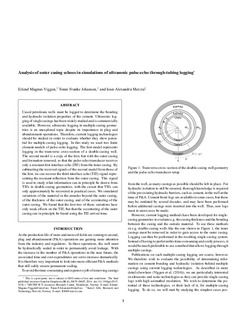Analysis of outer-casing echoes in simulations of ultrasonic pulse-echo through-tubing logging
Journal article
Permanent lenke
http://hdl.handle.net/11250/2412668Utgivelsesdato
2016Metadata
Vis full innførselSamlinger
- Publikasjoner fra CRIStin - SINTEF AS [5802]
- SINTEF Digital [2501]
Sammendrag
Cased petroleum wells must be logged to determine the bonding and hydraulic isolation properties of the cement. Ultrasonic logging of single casings has been widely studied and is commercially available. However, ultrasonic logging in multiple-casing geometries is an unexplored topic despite its importance in plug and abandonment operations. Therefore, current logging technologies should be studied to evaluate whether they indicate the potential for multiple-casing logging. In this study, we used two finite-element models of pulse-echo logging. The first model represents logging in the transverse cross section of a double-casing well. The second model is a copy of the first, but with the outer casing and formation removed so that the pulse-echo transducer receives only a resonant first interface echo from the inner casing. By subtracting the received signals of the second model from those of the first, we can recover the third interface echo (TIE) signal representing the resonant reflection from the outer casing. This signal is used to study what information can, in principle, be drawn from TIEs in double-casing geometries, with the caveat that TIEs can only approximately be recovered in practical cases. We simulated variations of the material in the annulus beyond the outer casing, of the thickness of the outer casing, and of the eccentering of the outer casing. We have determined that the first two of these variations have only weak effects on the TIE, but that the eccentering of the outer casing can, in principle, be found using the TIE arrival time.
Beskrivelse
-
